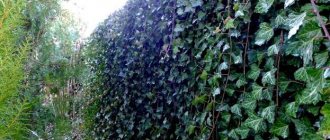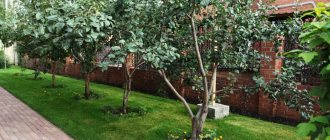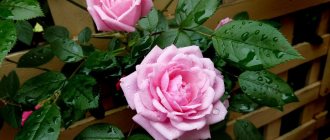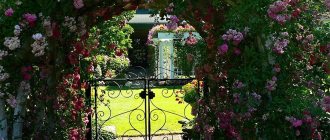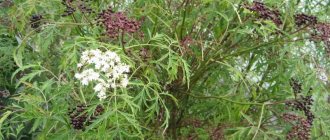Review author: Terrari School of Design
To transform their plots, gardeners have increasingly begun to use vertical gardening in the form of flowering and decorative deciduous vines. Climbing plants are original, practical and decorative.
Planting vines in a garden plot will allow:
- hide defects on the walls of outbuildings or a country house;
- create cozy areas on the site;
- make an elegant design of the fence around the site;
- decorate the gazebo with flowers and greenery.
With the help of vines you can create landscaping and decorate the area in a vertical direction. Lianas are able to create a certain microclimate in a separate area of the site, conducive to growing capricious plants or flowers around them, attracting insects for pollination. There are types of vines that bear fruits suitable for human consumption.
The photo shows popular types of vines for the garden.
Types of vines for the garden plot
Lianas are native to tropical forests. There they grow, intertwining trees and creating almost impassable places.
Lianas are popular in temperate climate zones in summer cottages and parks.
Plants grown in garden plots are divided into two large types of vines:
- perennial, having tree trunks and withstanding winter cold without shelter;
- annual herbaceous plants with thin stems that die off in winter.
Actinidia is a distant relative of kiwi
Actinidia can be grown as an ornamental or fruit plant, it all depends on the variety. This is a powerful vine that changes the color of the foliage from white at the beginning of the growing season to pink after flowering.
Actinidia shoots reach 7 meters in length. This is enough to make decorative pergolas, arches, and also selectively decorate the walls of a house, buildings, or gazebos.
Actinidia is unpretentious in care, but will respond positively to regular watering. The plant grows on any type of soil, tolerates partial shade, and is not afraid of frost. therefore, it can be grown in dachas in central Russia and even in Siberia.
The vine is heavy, so increased demands are placed on the strength of the support.
Perennial vines
Perennial plants are evergreen, do not lose their leaves in winter and have falling leaves. The most popular perennial vines for the garden are the following:
- Climbing rose, with long flowering under warm sunlight, is not picky about the soil.
- Common ivy has dense foliage, is unpretentious, and grows well in cold Siberian regions.
- Climbing or wild grapes have a good ability to cling to rough surfaces. At the beginning of growth, the grapes have bright green leaves, and in the fall they turn red;
- Garden grapes. This vine requires more attention. Clusters with fruits must be trimmed as they ripen, make sure that there is proper branching and be sure to protect them from frost for the winter.
- Honeysuckle comes in different varieties, both with flowers and beautiful leaves. It takes root in any soil, but for better growth it is advisable to plant it in sandy or loamy soil.
- Clematis blooms beautifully in different shades depending on the variety. The plant is capricious and demanding, heat-loving, grows well in sandy-clay soil.
Shade-loving
This last species includes climbing vines that almost never bloom, but look very impressive on their own. These are different types of ivy and lemongrass.
We recommend reading:
Laying artificial turf with your own hands: how to choose and step-by-step description of how to lay a lawn (100 photos)How to lay rolled lawn - step-by-step master class and tips on how to lay rolled lawn correctly (120 photos + video)
The best flower clock - a step-by-step description of how to make a beautiful element of landscape design correctly
Having grown along the base, such vines produce many leaves that weave all around like a hedge.
Some of them, such as, for example, many types of lemongrass, change the color of their foliage at different times of the year and become golden, scarlet, or dark green.
Such plants require almost no care at all. All you need to do is prune them from time to time and keep an eye on their spread.
Almost all of these species are very tenacious, and even if they died during the winter cold, the first accidentally remaining roots or seeds will begin to grow in the spring.
This is especially true for different types of hops, which grow at a tremendous speed, but are very attractive in appearance and smell pleasant.
Growing perennial vines
Creepers are best planted in a sunny location.
The root system must have space because it needs food and room to grow. This must be taken into account when planting.
It is not advisable to plant slow-growing ones next to fast-growing vines.
For vines, the material from which the support is made is of great importance. It is not recommended to use metal supports, as they heat up from the sun's rays and can burn the shoots. Therefore, the best supports for vines will be those made:
- made of wood;
- made of plastic;
- made of brick;
- made of stone.
Lianas require pruning during growth. They help control growth and shape, and also rejuvenate the plant.
Not all types of vines shelter for the winter. Clematis and roses need shelter.
Chinese lemongrass - a beautiful and useful plant
The homeland of Chinese lemongrass is the Far East, but the vine also grows in the conditions of central Russia. This plant is frost-resistant, moisture-loving, and differs from other vines in its slow growth.
The length of the shoots of an adult plant reaches 4 meters. The shoots are arranged tightly, which makes it possible to use lemongrass for landscaping decorative walls and gazebos. Green foliage turns bright yellow in autumn. Ripening berries turn red.
Schisandra can be planted next to trees. He will use them as a support, but will not break branches and deprive the trees of their strength. It is also acceptable to use it for decorating the walls of buildings, gazebos, and other architectural objects of a summer cottage.
Chinese lemongrass leaves are used in folk medicine.
Annual vines
Annual vines bloom throughout the summer season. They can braid a three-meter support with their stems in three weeks. Representatives of popular annual plants are:
- Morning glory. This is a type of climbing vine with gramophone-shaped flowers that bloom all summer and in September. They themselves find support, wrapping themselves around it. They are suitable for landscaping a fence or wall.
- Dolichos purple. It blooms in the form of large, showy inflorescences with flowers of indeterminate shape (May-September). Purple bean pods ripen in August. The scourge reaches three meters in length. Dolichos grows well in shaded areas.
- Sweet pea. The plant is good for decorating low fences. Peas easily cling to the tendrils, bloom constantly and have a pleasant aroma.
- Thunbergia. The leaves are heart-shaped, and the flowers come in white, beige and other shades, with a dark center. The size of the flowers is about 5 centimeters.
- Kobeya. A fast growing plant that can grow up to 10 meters in length over the summer. The flowers are bell-shaped. Lover of moist air and sun.
- Decorative beans. One of the beautiful vines that easily entwines the provided support and in a short time is transformed into a decorative hedge.
It is recommended to plant annual vines next to perennial ones (they need time to acclimatize and take root). Annuals will be able to make up for the lack of greenery of their relatives while they become woody.
Honeysuckle Honeysuckle
This fragrant, spectacular vine loves the sun, but can also tolerate partial shade. It reaches its maximum size after 5-6 years of life.
Honeysuckle honeysuckle is not picky about soil acidity, but prefers areas with fertile, well-drained soil. Liana can withstand frosts down to –25°C. Propagated by cuttings, seeds and layering.
Honeysuckle honeysuckle is one of the most traditional vines for pergolas and gazebos. During flowering, it attracts a huge number of butterflies and bees and fills the garden with a pleasant aroma.
| Vine length (m) | Flowering time | Soil type | Peculiarities |
| 4-8 | Late May – mid July | Fertile, moist, loose | For good flowering, formative pruning is required in March-April. |
Growing annual vines
Annual vines are planted with seeds or seedlings. Transplantation into the ground is carried out in mid-May, when frost is no longer expected. Lianas grow very quickly, so supports are installed at the time of planting so as not to damage the roots of the seedlings.
When caring for plants you must:
- carry out watering;
- remove excess shoots;
- tie up whips;
- feed.
When the plant stops blooming and the leaves begin to fall, it must be removed from the site along with the root system.
Hops - an unpretentious plant
For most summer residents, hops growing on the site are a natural disaster. It grows quickly: within a month, shoots can reach a length of up to 5 meters. Powerful vines entangle trees, depriving them of their strength, are not afraid of frost, are insensitive to herbicides and can grow on any type of soil.
The vines are covered with thin tendrils that scratch and burn the skin. Therefore, hops are not used to decorate gazebos and fences located near garden paths. It would be appropriate to decorate the walls of outbuildings and fences.
Hops also reproduce by seeds, which can be carried by the wind throughout the area. Therefore, the cones need to be cut off.
Lianas growing in the shade
For many gardeners, the issue of planting vines in a shaded area is relevant. It is not recommended to plant flowering vines in the shade due to a decrease in the abundance of flowering.
You can choose the following types of decorative shade-loving vines for the garden:
- Ivy;
- large-leaved Kirkazon (possesses frost resistance);
- Schisandra chinensis. Evergreen lemongrass is suitable for the southern regions, and deciduous species are acceptable for the western regions.
Lianas are a type of plant that will bring joy to any gardener. They are highly decorative, practical, and come in a variety of varieties and types. With the help of vines you can create a unique garden design.
General information
A feature of climbing garden vines is their thin stem, which does not allow them to hold massive foliage vertically. Ornamental vines for the garden adapt to survival by attaching to vertical supports with tendrils, suckers, shoots, thorns and auxiliary roots.
Lianas originate from the tropics and subtropical countries of Africa, Asia and America, but have long been acclimatized not only on European territory, but also in the harsh Siberian and Far Eastern conditions. Photos of vines for the garden delight all lovers.
There are many varieties of climbing plants, which are usually classified into two broad categories: annuals and perennials. Both groups include decorative and fruit-bearing varieties.
Photo of vines in the country
Tree pliers - a plant for open spaces
The liana received the name “tree plier” due to its parasitism on trees. The plant uses them as a support, while the branches are partially entwined and partially pierced through by a powerful vine. As a result, the tree dies. This quality can be used if unnecessary trees grow on the site that cannot be cut down and uprooted.
The tree plier reaches a length of up to 10 m, but most often the shoots do not exceed a length of 5 m. The foliage is abundant, densely located along the vine, the inflorescences are ugly, but the orange-red berries provide additional decorativeness.
Wood pliers are easy to care for, are not afraid of frost, and patiently tolerate drought. It can be planted at a distance from garden and ornamental trees, and not insulated for the winter.
Several varieties of the plant are known, the most popular being the corymbose wood pliers and the braided wood pliers.
Wisteria
Most of all, wisteria react not to the composition of the soil, but to climatic conditions and location. The site must be protected from the wind, the soil must be free from the slightest accumulation of water and the presence of lime. Otherwise, this will lead to the death of the plant. Wisteria grows very strongly, so that the powerful branches do not break under their weight; reliable support is necessary, which is why it is most often used to decorate pergolas. Pruning of the crop is carried out twice a year - this stimulates the growth of new buds and, as a result, lush flowering.
- In spring - shortening old shoots and side branches by 30-40 cm;
- In autumn, young shoots are cut to 4-5 buds.
Aristolochia macrophylla, or kirkazon
Aristolochia macrophylla, or kirkazon , attracts attention with its unusually large leaves (up to 30 cm) and flowers similar to the bells of a saxophone. Grows best in shade and partial shade. For the winter, young plants are covered or removed from their supports and laid on the ground. Attached to the support by flexible shoots and leaf petioles. It is necessary to additionally tie it to the support with twine and direct it towards the support.
Kirkazon, or Aristolochia macrophylla
Ivy
Ivy is the most shade-tolerant of all decorative deciduous vines. Its unique ability to climb along sheer walls is used in decorating buildings, tunnels, arches and garden structures. He is completely unpretentious and tolerates haircuts without pain. Its only drawback is its lack of winter hardiness, so in regions with winter temperatures below -10 degrees, the plant needs additional shelter.



